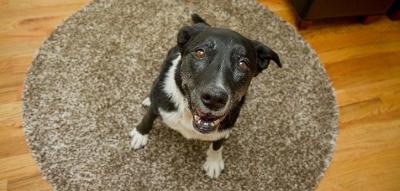
Feeding Your Dog
Are you wondering what to feed your dog?
There are many good-quality dog foods for sale; read the labels and talk with your veterinarian if you need help deciding what to feed your dog. Many people only feed their dog dry food, since it’s more convenient to serve, has less odor, is less likely to spoil in the bowl, and can reduce the buildup of tartar on the dog’s teeth.
There are also many nutritionally complete wet dog foods for sale. Many people use wet food as a treat, as a way to hide daily medications, or as a way to increase water intake (sometimes this is medically indicated). Any wet food remaining uneaten after 20 minutes should be thrown away. If you are committed to vegetarianism, dogs can do fine on a commercial vegetarian diet. Remember to have fresh, cool water available for your dog at all times.
What else do you need to know about feeding your dog?
To know whether your dog’s appetite is normal, supervise your dog while she’s eating. If you have more than one dog, supervising their mealtimes will ensure that the dogs do not eat each other’s portions or the wrong food.
If a dog eats too much or too fast, or exercises too soon after a meal, he can get bloating or GDV (gastric dilatation and volvulus). Deep-chested breeds are at higher risk, but if any dog shows discomfort after eating or has a visibly bloated abdomen, seek medical attention right away. GDV is very painful and will be fatal if left untreated.
Home starts with you
Should you change your dog’s diet over the course of his or her life?
You should change your dog’s diet according to age and special needs requirements. Most puppies are eating dry puppy food by six weeks of age; they need three or four small fresh meals offered throughout the day. At six months, puppies can go down to two meals per day. If your puppy is going to grow to be a large dog, he may benefit from an attempt to slow his growth through diet change. Ask your veterinarian when you should transition from puppy to adult food.
Know what a good weight is for your dog and watch his weight as he gets older. If your dog does not have a visible waistline, have your veterinarian take a look at him. There may be a medical cause for his weight gain, or you may need to give him more exercise and switch to a “light” dog food.
Here are some special circumstances that may mean a change in your dog’s diet:
- Sometimes, skin problems, ear infections and digestive problems are signs of food allergies. Discuss with your veterinarian whether a diet change is indicated.
- Some medical conditions, such as kidney disease or diabetes, require special diets.
- Most older dogs need to be fed “senior” dog food. Extra-large breeds and some mixes age faster than other breeds. Ask your veterinarian when your dog should begin eating a senior diet.
If you have any questions or concerns, discuss your dog’s diet with your veterinarian during regular checkups. If you plan to change your dog’s diet, do it gradually. Start by mixing 25 percent of the new food with 75 percent of the old food. Slowly increase the amount of new food over the course of three days until you are feeding her all new food. Some dogs try to pick out just the old familiar food to eat, but don’t worry: one small or missed meal will not hurt a healthy dog. While you’re making the change, don’t offer your dog other foods, treats or table scraps, or you may be promoting finicky eating behavior.
What should you avoid feeding your dog?
You should avoid the following:
- Alcoholic beverages (they can cause coma and even death)
- Cat food (it’s generally too high in protein and fats)
- Caffeine (it can be toxic, and adversely affect the heart and nervous system)
- Chocolate (in large amounts, chocolate can also be toxic)
- Fat trimmings (they can cause pancreatitis)
- Raisins and grapes (they can damage the kidneys)
- Nicotine (it affects the digestive and nervous systems, and can result in rapid heartbeat, collapse, coma and death)
- Table scraps (they are not nutritionally balanced)
Excess salt, sugar and fats can cause obesity, dental problems and finicky eating in your dog. For a happy dog, feed him a healthy diet and get plenty of exercise together.
